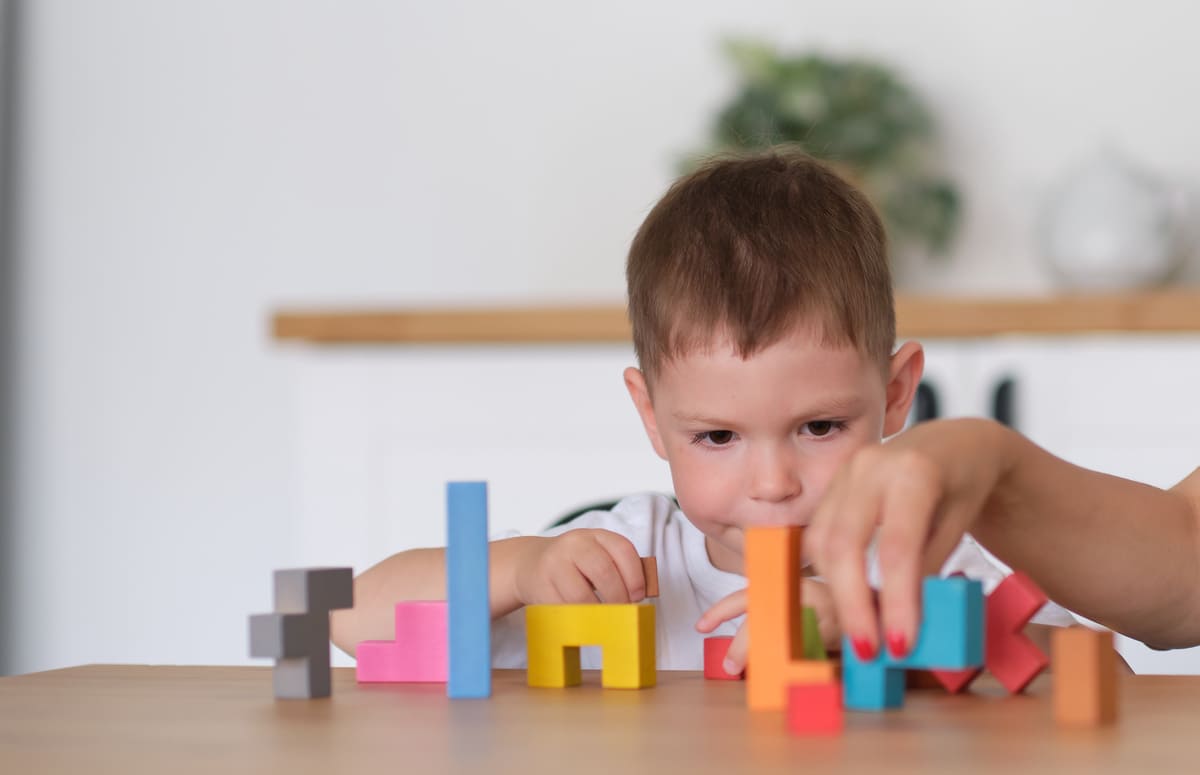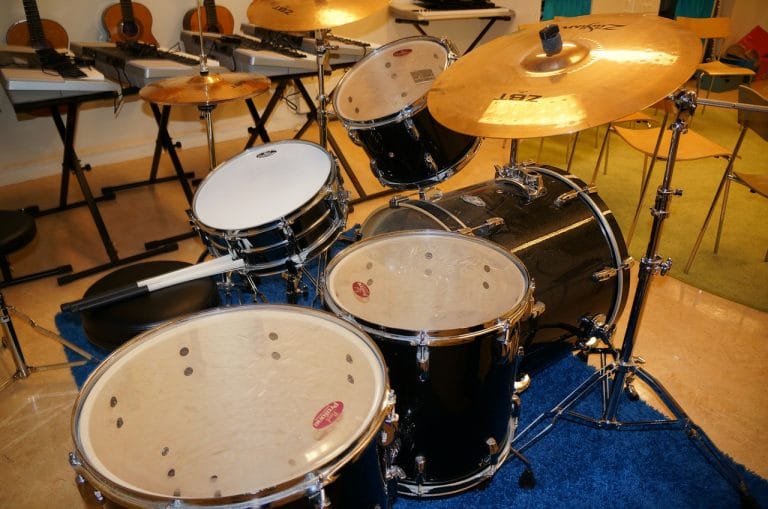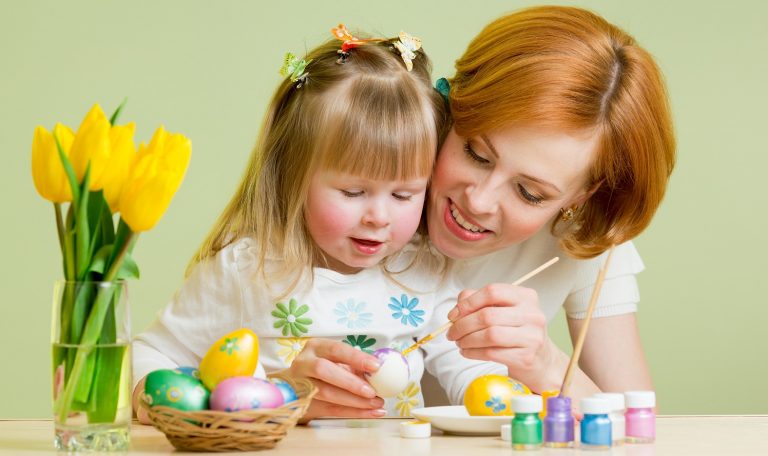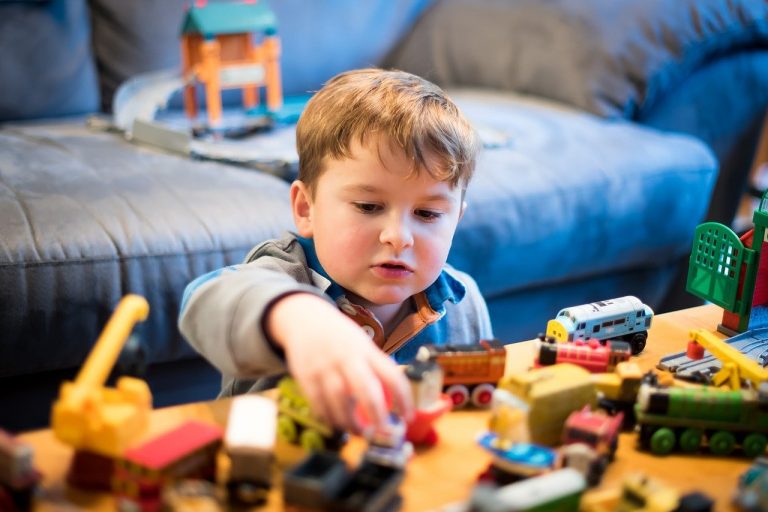Indoor games are a great way to keep kids entertained and engaged, especially during times when it’s snowing, raining or when they cannot go outside. Fun indoor activities provide a way for kids to stay active, promote social interaction, and develop important skills that will benefit them throughout their lives.
Generally, parents opt for board games or card games for kids as indoor activities, but there are many options that will keep kids engaged and entertained. In this blog, we have created a list of the 25 best indoor games for kids to play at home that will keep them occupied and having fun! These fun games are suitable for kids of all ages and can be enjoyed with the whole family.
In This Article
What are the Benefits of Indoor Games?
Indoor games offer a multitude of benefits for both children and adults. Let’s dive into some of the key advantages that make indoor games a popular choice for entertainment:
- Stress Relief and Mental Well-being: Engaging in indoor games can help reduce stress levels and promote mental well-being. Games offer an escape from daily pressures, helping individuals to relax.
- Quality Time with Family: Indoor games create an opportunity for families to bond and spend quality time together. Playing board games, card games, or team-based activities strengthens familial relationships.
- Cognitive Skill Development: Many indoor games stimulate the brain and foster cognitive skill development in kids of all ages.
- Increased Productivity: Playing indoor games boosts productivity. Taking short breaks for enjoyable games improves focus, concentration, and rejuvenates the mind.
- Encouragement of Creativity: Indoor games foster creativity and imagination. Crafts, building blocks, and art activities empower children to explore their artistic side and think creatively.
- Improved Hand-Eye Coordination: Indoor games improve hand-eye coordination, which is essential for writing, typing, and playing musical instruments.
- Lowered Blood Pressure: Playing indoor games can positively impact blood pressure. Research shows that enjoyable activities reduce stress and lower blood pressure.
- Safe and Secure Environment: Indoor games offer a safe environment with minimal risk of physical injury, making them ideal for children. Parents can relax, knowing their little ones are protected while having fun.
- Reflexes: Playing kids indoor games that involve quick thinking and fast reflexes can help improve these skills, which are important for daily life.
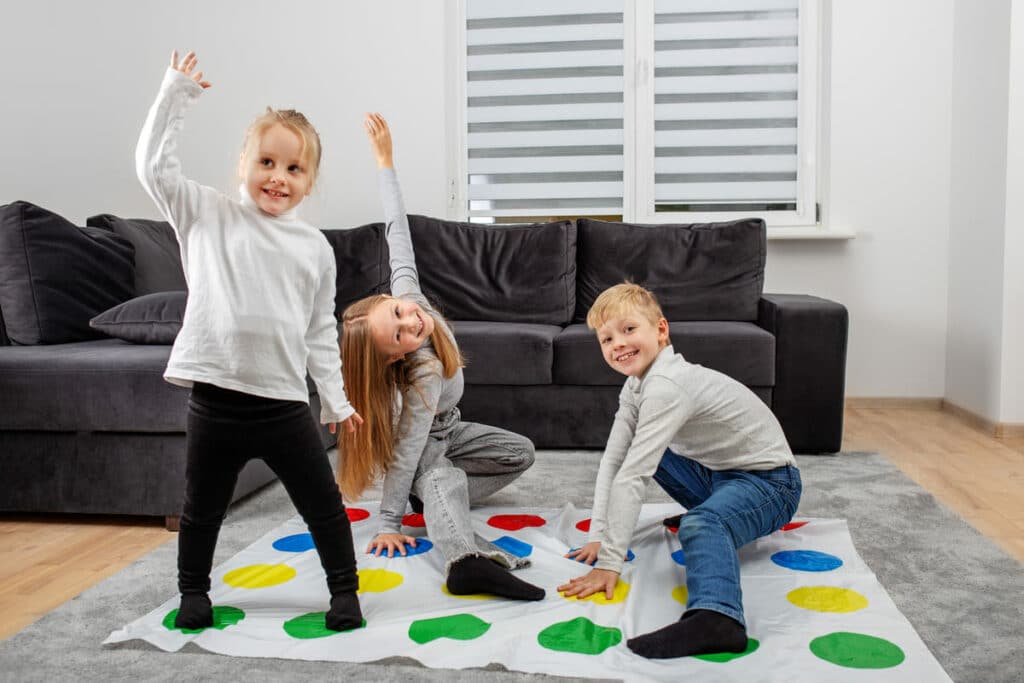
Kids Age-Appropriate Games
Indoor games are a great way to keep kids entertained and occupied, especially when the weather outside is not so friendly. However, it is essential to choose age-appropriate games that are suitable for the developmental stage of the child. For younger kids, simple games that involve movement and imagination are ideal. As kids get older, they can handle more complex and strategic games. Look at the table below to know what age is suitable for which game:
| Age Range | Suitable Games |
| 3-4 years | Simon Says, Hot Potato, I Spy, Puzzles |
| 4-5 years | Musical chairs, Memory games, Pictionary, |
| 5-6 years | Scrabble Junior, Chess, Monopoly Junior, Uno |
| 7-9 years | Treasure Hunt, Battleship, Connect Four, Jenga |
| Teenagers and up! | Scrabble, Chess, Monopoly, Codenames |
Best Indoor Games for Kids
Indoor games are a great way to keep children entertained and engaged, especially during a rainy or snowy day. For your child’s proper growth and development, it is important to keep them active physically as well as mentally. Here are some fun easy indoor games for kids to play at home:
1. Musical chairs

Musical chairs is a classic game that children have enjoyed for generations. It is a simple game that requires chairs to be arranged in a circle with one less chair than the number of children playing. As music plays, the children walk around the chairs, and when the music stops, they must find a chair to sit on. Playing this game with younger children, you need basic musical skills to make it enjoyable. It helps children learn to take turns and follow simple rules while having fun.
Age Group: 5 years old and above
What Will You Need?
- To play this fun indoor game, you will need chairs and music speakers
How can you play this game?
- Arrange chairs in a circle, facing outwards, with one less chair than the number of players.
- Start the music and have the players walk in a circle around the chairs.
- Suddenly, stop the music and have all players quickly sit in an empty chair.
- The person without a chair is out of the game.
- Remove a chair each time until only one person remains.
Musical Chairs Can Help Kids To Develop:
- Practice patience
- Spatial awareness
- Social skills like sharing and taking turns
- Develops listening skills
2. Simon Says

Simon Says is one of the popular fun indoor games for kids at home. It is a great way to keep children active and entertained. It requires one person to be the “Simon” who will give instructions, such as “Simon says touch your nose.” The other players must follow the instructions only when they start with, “Simon says. This listening game is perfect for developing children’s listening skills and following directions.
Age Group: 3 years old and above
What Will You Need?
- At least three people or paper
How can you play this game?
- Choose one person to be the “Simon” and have all players line up in front of them.
- “Simon” will give different instructions starting with, “Simon says, “such as, “Simon says touch your toes”.
- The players must only follow the instruction if it starts with “Simon says”.
- If “Simon” instructs without saying “Simon says”, the player who follows that instruction is out of the game.
- Continue playing until one player is remaining.
Simmon Says Can Help Kids To Develop:
- Listening skills
- Following instructions
- Quick thinking and reacting
- Cognitive development
3. Hide and Seek

Hide and Seek is a fun game that children love to play, and it is a great way to keep them active. One person counts while the others hide. The seeker must try to find all the players before they reach “home base”. This game can be played with two or more people and can go on for as long as time permits.
Age Group: 4 years old and above
What Will You Need?
- A safe and spacious indoor area
- Obstacle course or hiding spots (optional)
How can you play this game?
- Choose one person to be the “seeker.”
- The seeker closes their eyes and counts to a predetermined number.
- While the seeker counts, the other players hide.
- Once the counting is completed, the seeker starts searching for the hidden players.
- The seekers must find all the hidden players within a time limit or until everyone is found.
- The last person found becomes the next seeker for the subsequent round.
Hide And Seek Can Help Kids To Develop:
- Physical activity
- Problem-solving skills
- Teamwork and communication
- Spatial awareness and memory
4. Puzzles
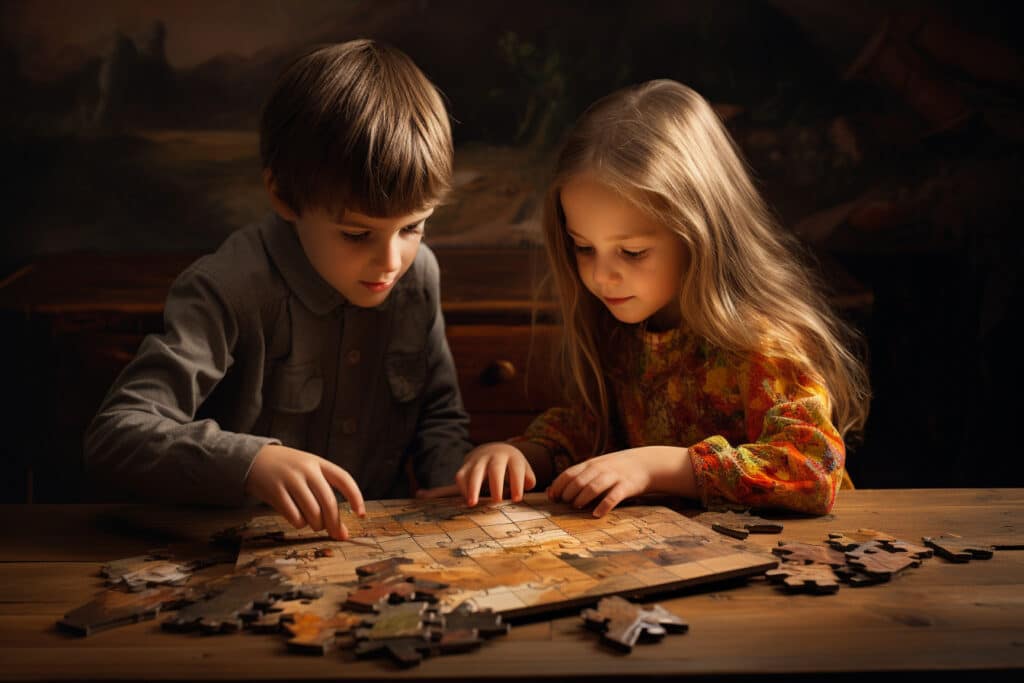
Puzzles are a fantastic way to challenge your problem-solving skills and enhance cognitive abilities. They come in various forms, such as jigsaw puzzles or brain teasers. This indoor game can be enjoyed both individually or with a group of friends, making it perfect for children to play at home. Puzzles also come in different difficulty levels so that they can be suitable for children of all ages.
Age Group: 2 years old and above
What Will You Need?
- A variety of puzzles (jigsaw, sudoku, brain teasers, etc.)
How can you play this game?
- Select a puzzle that matches your interest and difficulty level.
- Lay out all the puzzle pieces or set up the puzzle according to the specific type.
- Start assembling the pieces or solving the puzzle based on the provided clues.
- Work individually or collaborate with others to complete the puzzle.
- Celebrate when the puzzle is successfully solved.
Puzzles Can Help Kids To Develop:
- Problem-solving skills
- Memory retention and recall
- Hand-eye coordination
- Patience and perseverance
5. Passing the Parcel

Passing the Parcel is an engaging game that revolves around passing a wrapped parcel from one person to another while music plays. When the music stops, the person holding the parcel unwraps a layer. With younger kids, small prizes or treats can be placed between the layers. The person who unwraps the final layer wins the prize.
Age Group: 4 Years old and up
What Will You Need?
- A small prize or treat
- Wrapping paper or layers of newspaper
- Music player
How can you play this game?
- Wrap the small prize in multiple layers of wrapping paper or newspaper.
- Gather the players in a circle and start playing or tapping familiar songs
- Pass the parcel quickly from one person to another around the circle while the music plays.
- When the music stops, the person holding the parcel unwraps one layer.
- Repeat steps 3 and 4 until the final layer is unwrapped and the prize is revealed.
- The person who unwraps the last layer gets to keep the prize.
Passing The Parcel Can Help Kids To Develop:
- Hand-eye coordination
- Fine motor skills
- Patience and anticipation
- Social interaction and cooperation
6. Hopscotch

Children have enjoyed this classic game for many years, and it is a great way to keep them active indoors. Hopscotch requires players to toss a marker onto numbered squares and then hop through the course, avoiding the square with the marker. This is one of the best indoor games for kids that can be played alone or with a group of friends.
Age Group: 3 years old and above
What Will You Need?
- Chalk or tape to make the hopscotch grid
- A marker, such as a stone or a beanbag
How can you play this game?
- Use chalk or tape to create a hopscotch grid on the floor.
- Each player takes turns tossing the marker onto a numbered square.
- The player must hop through the course, skipping the square with the marker on it.
- If a player completes the course, they can toss their marker onto the next square and continue.
- If a player steps on a line or falls while hopping, they are out of the game.
- Continue playing until all players have had a turn, and the last player standing wins.
Hopscotch Can Help Kids To Develop:
- Gross motor skills
- Balance and coordination
- Counting and number recognition
- Creativity and imagination
7. Hot potato

Hot potato is a fast-paced game for young kids that requires players to pass or toss an object, such as a ball or stuffed animal, while music plays. When the music stops, whoever is holding the “hot potato” is out of the game. The last person standing wins! This game is perfect for developing motor skills and hand-eye coordination.
Age Group: 4 Years and above
What Will You Need?
- A lightweight object like a ball or stuffed animal
How can you play this game?
- Have all players sit in a circle.
- Start the music and have the players pass the “hot potato” around the circle.
- When the music stops, whoever is holding the “hot potato” is out of the game.
- Continue playing until only one player remains.
Hot potato Can Help Kids To Develop:
- Hand-eye coordination
- Motor skills
- Quick thinking and reacting
- Reaction time and reflexes
8. Scrabble

Scrabble is a classic word game that the whole family can enjoy. It is not only fun but also educational, as it helps children improve their vocabulary and spelling skills. Scrabble can be played with two or more players, and it is perfect for a cozy night. To avoid an indoor obstacle course, play the game on a large table surface.
Age Group: 3 Years and above
What Will You Need?
- A Scrabble board game
How can you play this game?
- Each player draws seven letter tiles from the bag and places them face down in front of them.
- The first player forms a word using their tiles and places it on the board either vertically or horizontally.
- The next player must then use some or all of their tiles to form a new word, connecting it to the existing words on the board.
- Points are scored based on the letters used and placement on bonus squares.
- Play continues until all tiles are used or players agree to end the game.
Scrabble Can Help Kids To Develop:
- Spelling and vocabulary skills
- Critical thinking and strategic planning
- Math skills (counting points)
- Social interaction and having fun with family or friends
9. Duck, Duck, Goose

Kids love this simple yet fun game that can be played indoors. Duck Duck Goose requires a group of children to sit in a circle while one child walks around tapping the heads of each player, saying “duck” until they choose someone and say “goose”. The chosen child must then stand up and chase the tapper around the circle, trying to tag them before they reach the empty spot. If the tapper gets tagged, they must sit in the empty spot and become the new “goose”.
Age Group: 4-5 years old and above
What Will You Need?
- At least four people
How can you play this game?
- Have all players sit in a circle facing each other.
- One player walks around the circle, tapping each player on the head, saying, “Duck,” until they say, “Goose,” and tap the chosen player.
- The chosen player must then stand up and chase the tapper around the circle and try to tag them before they reach the empty spot.
- If the tapper gets tagged, they become the new “goose,” and the game continues.
- If the tapper makes it back to the empty spot without getting tagged, the chosen player becomes the new “tapper.”
Duck, Duck, Goose Can Help Kids To Develop:
- Physical activity
- Gross motor skills
- Social skills like taking turns and sharing
- Hand-eye coordination
10. Pictionary

Pictionary is a great indoor game for kids that combines drawing and guessing. It is a perfect game to spark creativity and imagination in children. Pictionary can be played with two or more players, making it a fun activity for the whole family.
Age Group: 4 years old and above
What Will You Need?
- Paper
- Pencils or markers
How can you play this game?
- Divide the players into teams of two or more.
- One player from each team takes turns drawing a word or phrase while the other players try to guess what it is.
- The team that guesses correctly gets a point, and the first team to reach a predetermined number of points wins.
Pictionary Can Help Kids To Develop:
- Creativity and imagination
- Communication skills
- Visual and spatial thinking
- Vocabulary and language skills
11. Hangman

Hangman is the best indoor game for kids who are learning to spell and read. It is a classic word-guessing game where one person thinks of a word and draws dashes for each letter. The other players have to guess the letters, and if they guess wrong, the person drawing the hangman adds another body part to the gallows. If they can’t guess the word before completing the drawing, they lose.
Age Group: 4 years old and above
What Will You Need?
- Paper and pencil or whiteboard
How can you play this game?
- One person thinks of a word and draws dashes on paper for each letter in the word.
- The other players have to guess letters one at a time.
- If they guess a correct letter, it is filled in all the appropriate dashes.
- If they guess wrong, one part of the hangman is drawn (head, body, arms, legs).
- Continue playing until the word is guessed or the hangman is complete.
Hangman Can Help Kids To Develop:
- Spelling and reading skills
- Vocabulary expansion
- Critical thinking and problem-solving skills
- Patience and persistence
12. Snakes and Ladders

Snakes and Ladders is a classic board indoor game that has been played for generations. It is a great indoor game for kids to play with their friends or family. The game involves rolling a dice, moving your piece accordingly on the numbered squares, and avoiding the snakes while trying to reach the top of the board.
Age Group: 3 years old and above
What Will You Need?
- Snakes and Ladders board game
How can you play this game?
- Roll the dice to determine who goes first.
- Each player takes turns rolling the dice and moving their piece accordingly on the board.
- If a player lands at the bottom of a ladder, they can climb up it to get closer to the finish line.
- If a player lands on a square with a snake’s head, they must slide down to the square where the snake’s tail ends.
- The first player to reach the top of the board wins.
Snakes and Ladders Can Help Kids To Develop:
- Counting skills
- Strategic thinking
- Patience and sportsmanship
- Basic math skills
13. Pitching Pennies

Pitching Pennies is a simple yet entertaining game that can be played indoors as long as you have a flat surface and some spare change. One player stands at one end of the table or floor while others stand at the other end. The objective is to toss coins closest to the wall without touching it. This is the perfect fun activity game for both younger and older kids.
Age Group: 4 Years and above
What Will You Need?
- A flat surface
- Spare change (coins or small objects)
How can you play this game?
- Choose an appropriate starting point for all the players.
- Each player takes turns tossing coins towards the wall.
- The closest coin to the wall wins that round and earns a point.
- Continue playing rounds until a predetermined score is reached or time runs out.
Pitching Pennies Can Help Kids To Develop:
- Hand-eye coordination
- Counting and math skills
- Precision and control
- Strategy and critical thinking
14. Rock Paper Scissors

Rock Paper Scissors is a simple yet fun game that can be played with just two players. This game involves making hand gestures to determine the winner. Rock beats scissors, scissors beat paper, and paper beats rock. It is an engaging way for children to use their hands and practice their counting skills.
Age Group: 3 years old and above
What Will You Need?
- Two players or more
How can you play this game?
- Each player makes a fist with one hand and then extends their thumb and index finger to make the shape of either rock, paper, or scissors.
- On the count of three, both players reveal their hand gestures.
- The winning gesture beats the losing one.
- If both players make the same gesture, it is a tie, and the game continues until there is a winner.
Rock, Paper, Scissors Can Help Kids To Develop:
- Fine motor skills
- Basic counting skills
- Decision-making and strategy-building
- Hand-eye coordination
15. Red Light, Green Light
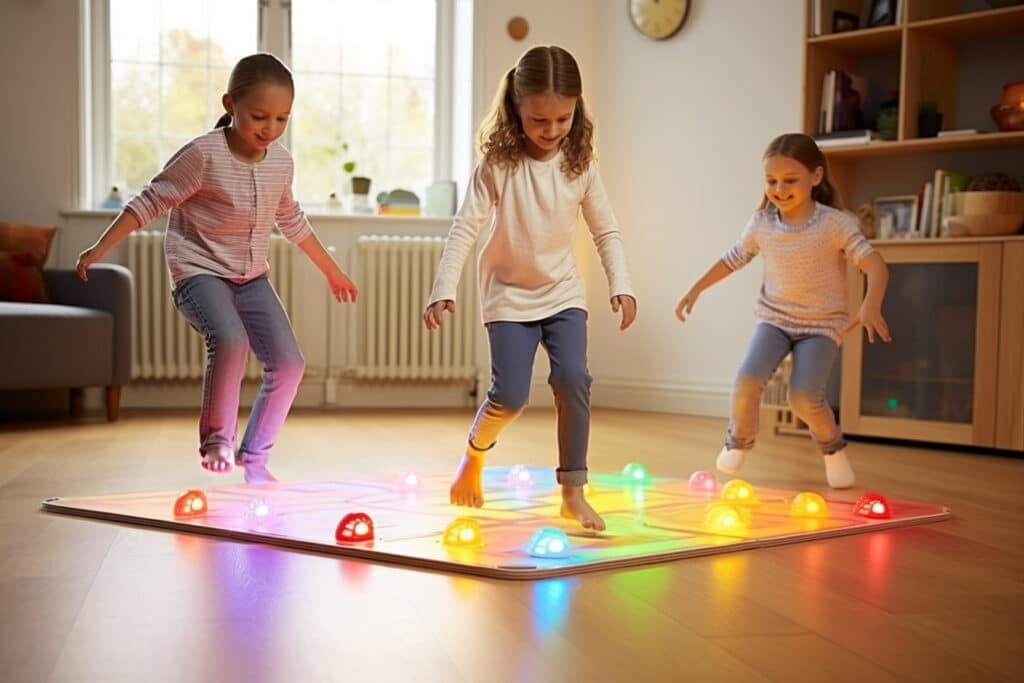
Age Group: 5 years old and above
What Will You Need?
- A safe indoor area with enough space to run
How can you play this game?
- One person acts as the “stoplight” while other players line up several yards away.
- The stoplight turns its back to the players and says, “Green light!”
- While the stoplight has its back turned, the other players run towards them as fast as they can.
- When the stoplight says, “Red light!” they turn around, and all players must freeze.
- Any player caught moving after “red light” is out of the game.
- The last player remaining wins and becomes the next stoplight.
Red Light, Green Light Can Help Kids To Develop:
- Physical activity and movement
- Listening skills and following directions
- Reaction time and decision-making
- Patience and self-control.
16. Spoiled Telephone

Spoiled Telephone is one of the best indoor group games for kids. It is a modern twist on the classic game of “Telephone”. The first player whispers a phrase or sentence to the next player, and they pass it on until the last player reveals what they heard out loud. This game can be hilarious as the original message usually gets misheard and misunderstood along the way.
Age Group: 4+ years old
What Will You Need?
- At least five players
How can you play this game?
- Have all players sit in a circle or line.
- The first player whispers a phrase or sentence to the next player.
- The second player then whispers what they heard to the next player, and so on.
- The last player will say out loud what they heard, which is often different from the original message.
- This can continue for as many rounds as desired, with each player starting a new message.
Spoiled Telephone Can Help Kids To Develop:
- Listening skills
- Memory retention
- Creativity and imagination
17. Jenga
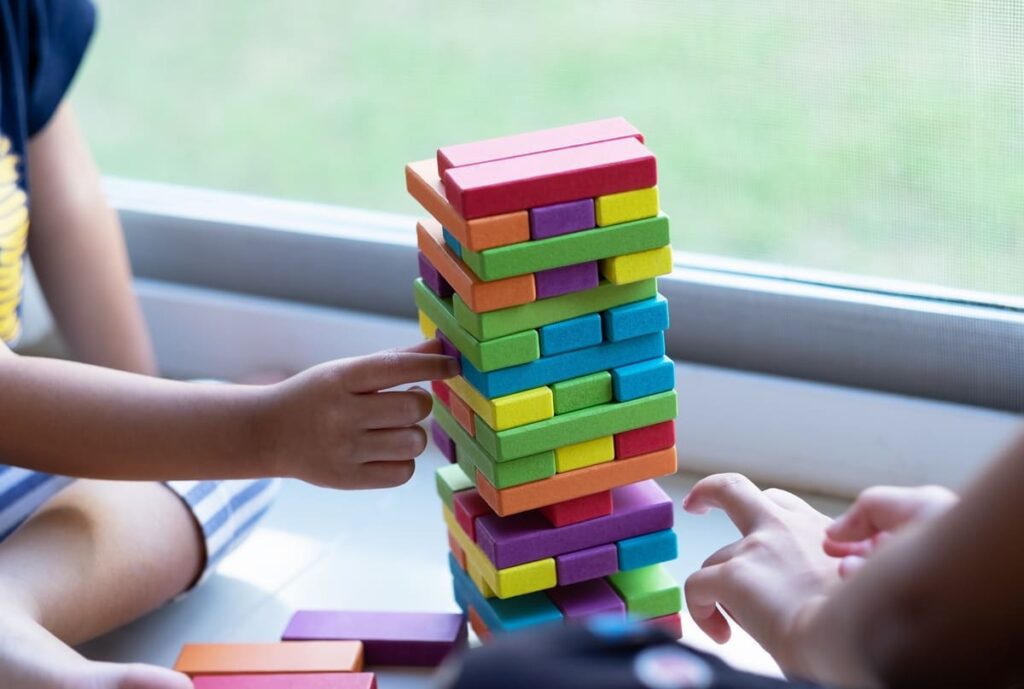
Jenga is one of the popular skill-building indoor games for kids at home. It requires players to remove one block at a time from a tower of wooden blocks without causing it to topple over. This game is suitable for children who are slightly older and have developed fine motor skills.
Age Group: 3 years old and above
What Will You Need?
- Jenga blocks set
How can you play this game?
- Stack the Jenga blocks in sets of three, each set perpendicular to the one below it.
- Each player takes turns carefully removing one block at a time from the tower.
- The player must place their removed block on top of the tower, creating a new level.
- The game continues until someone causes the tower to topple over.
Jenga Can Help Kids To Develop:
- Hand-eye coordination
- Fine motor skills
- Problem-solving and critical thinking
- Patience and focus
18. Connect Four

Connect Four is a strategic game that requires players to use their critical thinking skills. The objective of the game is to connect four pieces of your color in a row, either horizontally, vertically, or diagonally, before your opponent does. This game can be played with two players and provides hours of fun for kids.
Age Group: 4 years old and above
What Will You Need?
- Connect Four game board
- Red and yellow discs (or any other two colors)
How can you play this game?
- Set up the board by placing it on a flat surface and inserting all the discs in the slots.
- Divide into two teams or players, each with their colored discs.
- Decide who goes first, and that player drops one of their discs in any open slot of their choice.
- Alternating turns, each player drops their discs in the slots until one of them connects four in a row.
- The first to connect four wins the game.
Connect Four Can Help Kids To Develop:
- Strategic thinking and problem-solving skills
- Logical reasoning
- Decision-making abilities
- Patience and sportsmanship
19. Monopoly

Monopoly is one of the fun indoor games for kids that never gets old. It is a classic board game that teaches children about money management, capitalism, and decision-making. The game involves buying properties, collecting rent, and building houses and hotels. It can get competitive but it is a great way to spend quality time with family or friends indoors.
Age Group: 5 years and above
What Will You Need?
- Monopoly board game
How can you play this game?
- Each player starts with a set amount of money and takes turns rolling the dice to move their game piece around the board.
- When a player lands on a property, they can choose to buy it or auction it off if they don’t have enough money.
- As players collect properties of the same color, they can start building houses and hotels to increase rent prices.
- The goal is to bankrupt the other players and become the last one standing with properties and money.
Monopoly Can Help Kids To Develop:
- Basic math skills
- Critical thinking and decision-making
- Understanding of money management
- Social interaction and negotiation skills
20. Ping-Pong Ball Catch N’ Toss

Ping-Pong Ball Catch N’ Toss is a fun and easy game that can be played indoors. Divide kids into two teams and have them pass a ping pong ball back and forth using red solo cups. This game requires hand-eye coordination and is great for developing fine motor skills. Kids will also learn to work as a team and communicate effectively.
Age Group: 5 Years old and above
What will you need?
- Red solo cups
- Ping-pong balls
How can you play this game?
- Divide children into two teams and have them stand opposite each other.
- Give one player from each team a red solo cup.
- The player with the ping pong ball tosses it to their teammate, who must catch it in the red solo cup.
- Once caught, the other team member has to toss it back using only the red solo cup.
- If a team member fails to catch or toss the ball successfully, they are out of the game.
- The last team standing wins the game.
Ping-Pong Ball Catch N Toss Can Help Kids To Develop:
- Hand-eye coordination
- Fine motor skills
- Focus and concentration
21. Guess with Your Hands
Guess with Your Hands is a fun game that requires players to use only their hands to guess what an object is. To play this game, choose an object and have one player hold it in their hand behind their back while the other players try to guess what it is by feeling it with their hands.
Age Group: 3 years old and above
What will you need?
- Different objects from around the house (such as a pencil, toy, or household item)
How can you play this game?
- Choose an object and have one player hide it in their hand behind their back.
- The remaining players must take turns to feel the hidden object and guess what it is.
- Give each player a chance to touch the object and make a guess.
- The player who guesses the correct object correctly becomes the next person to hide an object.
Guess With Your Hands Can Help Kids To Develop:
- Sensory and tactile skills
- Problem-solving and critical thinking
- Fine motor skills
- Communication and descriptive language
22. Treasure Hunt

Treasure Hunt is one of the best fun team-building games for kids. It is an indoor game that can be played with a group of children. This game involves finding hidden objects or clues, leading to a final treasure. It can be made more complicated by adding riddles or puzzles along the way.
Age Group: 5 years old and above
What will you need?
- A designated area for the treasure hunt
- Hidden objects or clues
How can you play this game?
- Hide the objects or clues in designated areas of the house.
- Divide the players into teams and give each team a list of items or clues to find.
- Set a time limit for finding all the hidden objects or solving all the riddles/puzzles.
- The first team to complete the treasure hunt wins.
Treasure Hunt Can Help Kids To Develop:
- Problem-solving skills
- Teamwork and communication
- Critical thinking
- Creativity and imagination
23. Target the Cups

Children love to play with balls. Target the Cups is a fun indoor game for kids that can be easily played at home. It requires children to throw small balls or socks into cups placed at different distances. However, the catch is that the cups are placed upside down, making it a bit of a challenge to get the balls in. This game can be played by one or more players.
Age Group: 4 years old and above
What will you need?
- Plastic cups
- Small balls or rolled-up socks
How can you play this game?
- Place plastic cups upside down on the ground at different distances.
- Stand a few feet back from the cups and try to toss small balls or rolled-up socks into the cups.
- Keep track of how many attempts it takes to get each ball in a cup, then switch positions with another player and play again.
Target The Cups Can Help Kids To Develop:
- Hand-eye coordination
- Gross motor skills
- Focus and concentration
- Mathematical skills (counting points)
24. Fort Building

Fort building allows children to use their creativity and imagination while having fun. It can also be a great bonding activity for siblings or friends. You can play it with cards, pillows, or even cardboard boxes. Moreover, this game does not require any specific rules, so children can let their imaginations run wild.
Age Group: 3 years old and above
What will you need?
- Materials for building forts such as pillows, blankets, cards, etc.
How can you play this game?
- Gather all the materials and divide them among the players.
- Each player or team is responsible for building their fort using the provided materials.
- Once all the forts are built, children can play inside or have a pretend battle between forts.
- When playtime is over, everyone can join in to knock down the forts together.
Fort Building Can Help Kids To Develop:
- Creativity and imagination
- Fine motor skills
- Teamwork and collaboration
- Problem-solving skills
25. Bubbles

Bubbles are a simple but fun indoor game for kids of all ages. It only requires a bottle of bubble solution, a bubble wand, and some space to play. Children love running around and trying to catch bubbles, and it is an excellent activity for hand-eye coordination. However, playing games like “bubble tag” or “keep the bubble in the air” can make this simple game more challenging and exciting.
Age Group: 3 years old and above
What will you need?
- Bubble solution
- Bubble wand (optional)
How can you play this game?
- Pour some bubble solution into a shallow container, such as a bucket or bowl.
- Have the children dip their wands into the solution and blow bubbles.
- For “bubble tag,” one player blows a bubble and tries to tag another player with it.
- For “keep the bubble in the air,” players must keep the bubble in the air using their wands without letting it touch the ground.
- Play different variations of this game, such as seeing who can make the biggest or smallest bubble.
Bubbles Can Help Kids To Develop:
- Hand-eye coordination
- Physical activity
- Creativity and imagination
- Social skills through group play
Safety Measures for Indoor Games
When it comes to indoor games, ensuring safety measures are in place is of utmost importance. Here are some essential precautions to consider for a safe and enjoyable gaming experience:
- Safety gear and equipment: The type of game determines the required safety gear, such as helmets, knee pads, elbow pads, and safety goggles. Ensure all players have the necessary protective gear.
- Warm-up and stretching: Before engaging in any physical activity, it is essential to warm up and stretch. This helps prepare the muscles and reduces the risk of strains or sprains.
- Proper supervision: Kids should always have proper adult supervision during indoor games. This ensures their safety and allows for immediate assistance if needed.
- Hydration: Staying hydrated is important during physical activities. Encourage players to drink water before, during, and after the game to prevent dehydration.
- First aid training and injury awareness: First aid training benefits adults and older children, enabling them to promptly handle common indoor game injuries and provide proper care in accidents.
- Playing environment: Make sure the playing environment is well-lit and suitable for the game. Remove any obstacles or hazards that could be risky for kids.
- Protective coatings: Consider adding protective coatings to goalposts, bleachers, walls, or other surfaces to minimize the impact of collisions or falls.
- Enforce safety rules: Establish and enforce safety rules for each game. Everyone involved should understand and adhere to these rules to maintain a safe environment.

